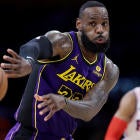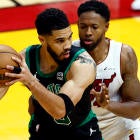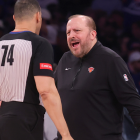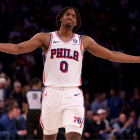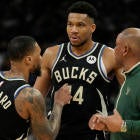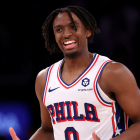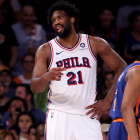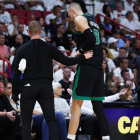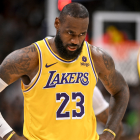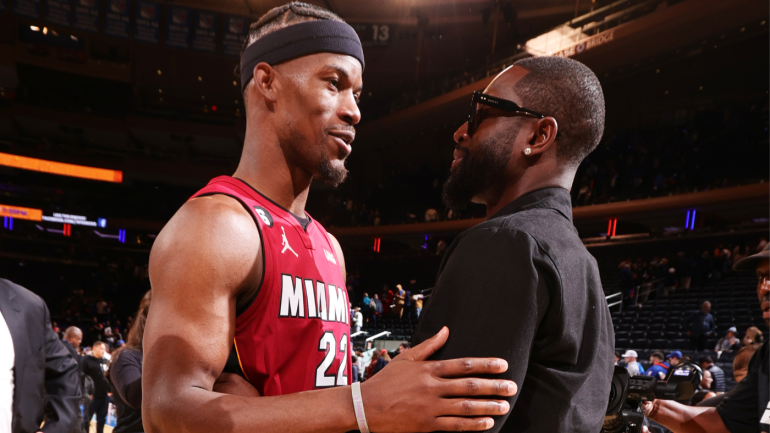
The last time the Miami Heat reached the Finals twice in a four-year span, they did so with one of the most star-studded rosters in NBA history. LeBron James, Dwyane Wade and Chris Bosh were all superstars in their prime when they won two championships together in Miami. Signing them was a slam dunk. The moment they arrived in south Florida, the Heat were virtually guaranteed contention.
But Miami's current roster? Not so much. The Heat are, essentially, a team of underdogs. Their best player attended Tyler Junior College. There are two top-10 picks on the entire roster, and they were both signed in buyout season. They signed their starting power forward based on the recommendation of rapper J. Cole.
The Heat look nothing like their glitzier self, yet here they are, right back in the Finals for the sixth time in the Erik Spoelstra era, but with an entirely different kind of team. Here's how Miami turned an island of misfit toys into the Eastern Conference champions.
An unlikely recruiter
Dwyane Wade is the sort of franchise icon that should never play for a second team. Yet the Heat, inching toward a rebuild after getting rebuffed by Kevin Durant in free agency, were no longer willing to prioritize Wade in 2016 free agency. They offered their legendary shooting guard a two-year deal worth $20 million. They'd eventually increase their offer, but the damage was done. Wade took a $47 million deal to play for his hometown Chicago Bulls. The relationship between team and star appeared severed forever.
Wade didn't have much success in Chicago. In his lone season as a Bull, he was knocked out in the first round and publicly squabbled with his younger teammates. But he met a kindred spirit in Chicago named Jimmy Butler. They played together for only a year, but that link would eventually lead Butler to Miami. "I've gotta give a shout-out to D-Wade," Butler said on Wednesday. "He always told me about this culture and how I fit here."
When the Minnesota Timberwolves looked to trade Butler in 2018, the Heat were widely considered the favorites to land him. They came up just short. But after a disappointing second-round exit, Butler was set for unrestricted free agency for the first time in his career. The Philadelphia 76ers decided to devote their financial resources to Al Horford and Tobias Harris, but the Heat still lacked the cap space to sign him outright. Miami, loaded down with bad contracts signed during their post-Wade stretch of mediocrity, needed to get creative.
Convincing Philadelphia to cooperate was easy enough. The 76ers were out of cap space and needed a shooting guard. Miami dangled the ascending Josh Richardson. A deal was struck quickly. However, league rules hard-cap any team that acquires a signed-and-traded player, so Miami could not spend more than $6 million above the luxury tax line. They were far above it when they agreed to the Butler deal. They somehow managed to pawn Hassan Whiteside off on the Portland Trail Blazers to make up the difference.
In Butler, the Heat found Wade's handpicked successor. Neither were highly regarded high-school recruits, yet both wound up at Marquette. Butler fell to the end of the first round in 2011 and needed to jump around to Minnesota and Philadelphia before settling into Miami, where he embodied the culture of hard work and conditioning that has come to define the Heat.
A tale of two centers
Miami's unceremonious dumping of Whiteside was the culmination of a steep three-year decline. The ultra-talented rim-protector fell out of the NBA for two years before Miami developed him into a starting-caliber center. After leading the league in blocks in 2016, the Heat rewarded him with a four-year max contract. Immediately, Whiteside's blocks dipped from 3.7 to 2.1 per game. His scoring, rebounding and field goal percentage fell as well.
Whiteside seemingly took his foot off the gas pedal after making his money. League observers certainly felt that way, with one scout telling Heat Beat Writer Ira Winderman that Whiteside "Could be a dominating center if he played hard every night and didn't get in his own way." Eventually, Miami got tired of Whiteside's inconsistency. Effort was never a problem for his replacement.
Bam Adebayo wasn't drafted for his numbers. "He was," Heat president Pat Riley told ESPN's Zach Lowe, "already a grown-ass man." He was a single-digit scorer in his first two Heat seasons, but he impressed the team with his hustle and defense. By the end of his sophomore campaign, Erik Spoelstra had seen enough. Hassan Whiteside started his last game as a member of the Miami Heat on Feb. 25, 2019. Adebayo has manned the middle ever since. From that perspective, the Whiteside trade didn't just clear the money needed for Butler. It officially handed the Miami defense to Adebayo.
South Dakota is lovely this time of year
Ever heard of Sioux Falls? If you looked up the opposite of Miami, it's roughly what you'd find. It's the 121st-most populated city in the United States and located in dreary South Dakota, but it is home to one of the most significant basketball development factories in the world. The Sioux Falls Skyforce are a pitstop for plenty of future Heat success stories on their way to NBA greatness. Notable alumni include Duncan Robinson and Gabe Vincent. Miami's G-League affiliate also got a close up look at players like Max Strus, as a member of the Windy City Bulls, and Haywood Highsmith, who starred for the Delaware Bluecoats.
The G-League has become a proving ground for unheralded Heat prospects. Of the 17 players currently on Miami's roster including two-way players, nine went undrafted. Once those players graduate from the G-League, they earn a sit down with, in the words of the New York Times' Scott Cacciola, Miami's "self-appointed dean of the undrafted."
"I take it personally when an undrafted guy comes here," Udonis Haslem told Cacciola. "I want them to be successful because I feel like that's a piece of my legacy." Haslem, who went undrafted and spent his first professional season in France, has now been a member of the Heat for 20 years. His jersey will undoubtedly be retired next season, and will serve as a message to all future undrafted members of the Miami Heat: put in the work, and this team will give you a chance to succeed.
The old guys still have it
Why do so many senior citizens flock to south Florida? The weather certainly helps. So do the low taxes. But where basketball is concerned, it's respect for a culture that can't be found anywhere else in the NBA. "I know a lot of these guys from being in the league for 15 years," Kevin Love said after signing with the Heat. "Having played against them, they're guys I admire, what they're about, as well as this team and this culture here. It's a special organization."
Virtually every Heat contender has featured a couple of aging stars nearing the end of their NBA journey. The 2006 Heat don't win it all without Gary Payton. Ray Allen saved the Heat in his second-to-last NBA season. But now? Most of Miami's bench is made up of basketball geezers. Love is 34, and joined a Heat team willing to give him minutes after the Cleveland Cavaliers decided not to. Cody Zeller may only be 30, but he has the hairline of a man several decades his senior. And then there's 36-year-old Kyle Lowry.
In many ways Lowry defies typical Heat dogma. He's never been known for his conditioning, and frequently used his hefty posterior as a weapon during his peak with the Toronto Raptors. He never quite got in sync with the Heat during his first season in Miami, missing much of it due to a personal issue. "I do think that he can be in better shape next year," Riley said after the Heat lost the 2022 Eastern Conference finals. "We'll address it and we'll try to help him as best as we can. Because it's not easy, when you get a little bit older."
His role reduced this season due to both a knee injury and the emergence of younger players. But by the end of the regular season, he'd grown comfortable coming off the bench. It's an easier job for those aging veterans. Miami has spent decades keeping their oldest players fresh enough to contribute when it counts. The Heat have done so yet again this season. Love, Lowry and Zeller are hardly the players they were in their prime, but the Heat are managing to milk a few extra months of high-end basketball out of the trio as they push for the fourth championship in team history.














